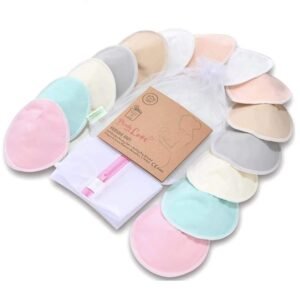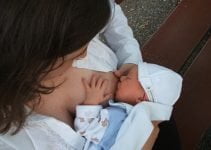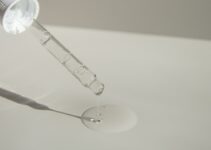Parenting is interesting but has its fair of challenges. Some of the demanding moments for a mother are the pregnancy and nursing stages.
 During those periods, often, milk seeps from the breasts. And if uncared for, it may cause you an embarrassment and stain your expensive clothes. And that’s where breast pads come in.
During those periods, often, milk seeps from the breasts. And if uncared for, it may cause you an embarrassment and stain your expensive clothes. And that’s where breast pads come in.
Disclaimer: This post might contain affiliate links. In case you buy through these links, we might receive a small commission, which helps us operate this website. Learn more here.
 So What Are Breast Pads?
So What Are Breast Pads?
Nursing pads, otherwise known as breast pads, are vital accessories for breastfeeding mothers. They are absorbent materials inserted behind the bra to absorb any unwanted milk leaks in between feeding. Often the pads are either of composite material or cloth.
But How Often Should I Change Breast Pads?
You can’t stick to one nursing pad forever; you’ll have to change it. However, the frequency depends on various factors and so from person to person.
But the bottom line is, a wet breast pad defeats its purpose and is risky to wear. Therefore as soon as it feels wet remove it out and wear another one.
So to know how often you need to change the nursing pads consider the following factors:
Factors Determining the Frequency of Changing Breasts Pads
Degree of Absorbency
The quantity of breast milk a breast pad absorbs dictates how frequently you need to change the bra pads. Often they are of two kinds; reusable and disposable.
People have different opinions on the two on which of the two possesses the highest degree of absorbency.
Most busy mothers claim disposable breast pads such as Lansinoh give them an easy time. It requires no washing, sticks easily, and has a thin profile that easily hides undetectably under the bra. Yet it absorbs milk 20 times its weight.
Disposable pads are often of bamboo, cotton, or polyester material. Whichever type of pads you use when it feels wet, change a fresh pair.
But if you feel reusable breast pads can suit your lifestyle, then the Keababbies organic Bamboo is a worthy consideration.
The Degree of Leakage
The quantity of milk leaking from your breast determines how frequently you’ll need to change the pads. However, on many occasions, a few weeks before and after delivery are when breast milk leakage is at its peak. Consequently, the pads may get wet quickly, thus requiring changing.
Naturally, disposable pads wick away moisture from the breast quickly, so the moment you feel wet, it signifies that they have absorbed to their maximum capacity.
Why Should I Change Breast Pads Often?
A breastfeeding mother should exercise a high level of hygiene. However, changing nursing pads often do more benefit than just keeping you hygienic;
Keeps Infection Away
Naturally, bacteria and yeast thrive best in a moist environment. Both reusable and disposable pads soon become drench with milk.
Continuing to keep a wet nursing pad on your breast is providing a favorable breeding place for yeast infection. Therefore as soon as you notice that the nursing pads grow wet, change them and avert nipple yeast infection.
However, for reusable breast pads, let them dry completely and then iron before reuse. Doing so ensures that you kill any traces of yeast infections.
Prevent Irritation of the Nipple
Nipple soreness or infection is highly irritating. Harboring wet pads may lead to the development of sore nipples. And when such nipples rub against the bra or pads, it’s highly painful.
Besides, painful nipples make it uncomfortable to breastfeed your baby. One sure way to prevent sore nipples, infections, or thrush is to change your breast pads as often as is necessary.
When Do I Need to Wear Breast Pads?
 Here are some of the instances when it’s beneficial to put on the breasts pads:
Here are some of the instances when it’s beneficial to put on the breasts pads:
Nearing the end of pregnancy, some women find it necessary to start using nursing pads. On the other hand, some mothers find it only necessary a few weeks following childbirth.
If you foresee being away from the baby for about 2 to 3 hours, wear nursing pads. That is especially so when your maternity leave ends, and you have to resume your office work.
Most often, babies don’t nurse frequently at night as during the day. Accordingly, some women find their breasts leaking heavily. Breast pads help to stop drenching your clothes or bedsheets.
If you are sick such that you can’t breastfeed the baby, then wearing pads is unavoidable.
Some mothers naturally find their bodies overproducing milk. If that’s so, then you should always have breast pads on all the time.
But are Breast Pads Safe?
Nursing pads are effective and safe in controlling breast milk leakage (when you use it correctly) in lactating mothers. However, remember to change it as soon as it feels wet. Yeast and bacteria breed in the damp area.
Verdict
So how often should I change breast pads? There aren’t any specific times of changing bra pads. Since it depends on several factors, as soon as you feel the breast pads feel wet, change them without delay.
With that, some women use about 3 to 5 or even 7 pads daily. The exact frequency depends on the extent of the leakage, the degree of the pad’s absorbency, and how long you plan to be away from the baby!
On the same note, the Lansinoh that gives a count of 200 pads should last you a month or even more. But whatever the case is, do not be contented with a wet breast pad!

 So What Are Breast Pads?
So What Are Breast Pads?


